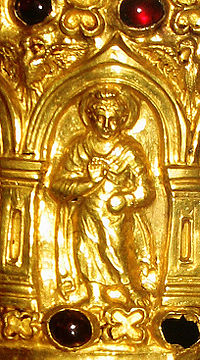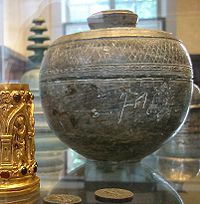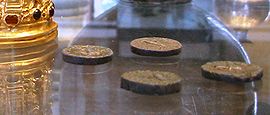
Bimaran casket
Encyclopedia

Reliquary
A reliquary is a container for relics. These may be the physical remains of saints, such as bones, pieces of clothing, or some object associated with saints or other religious figures...
for Buddhist relics that was found inside the stupa
Stupa
A stupa is a mound-like structure containing Buddhist relics, typically the remains of Buddha, used by Buddhists as a place of worship....
no.2 at Bimaran, near Jalalabad
Jalalabad
Jalalabad , formerly called Adinapour, as documented by the 7th century Hsüan-tsang, is a city in eastern Afghanistan. Located at the junction of the Kabul River and Kunar River near the Laghman valley, Jalalabad is the capital of Nangarhar province. It is linked by approximately of highway with...
in eastern Afghanistan
Afghanistan
Afghanistan , officially the Islamic Republic of Afghanistan, is a landlocked country located in the centre of Asia, forming South Asia, Central Asia and the Middle East. With a population of about 29 million, it has an area of , making it the 42nd most populous and 41st largest nation in the world...
.
When it was found by the archaeologist Charles Masson
Charles Masson
Charles Masson was the pseudonym of James Lewis, a East India Company soldier and explorer. He was the first European to discover the ruins of Harappa near Sahiwal in Punjab, now in Pakistan.-Early life:...
during his work in Afghanistan
Afghanistan
Afghanistan , officially the Islamic Republic of Afghanistan, is a landlocked country located in the centre of Asia, forming South Asia, Central Asia and the Middle East. With a population of about 29 million, it has an area of , making it the 42nd most populous and 41st largest nation in the world...
between 1833 and 1838, the casket contained coins of the Indo-Scythian king Azes II
Azes II
Azes II , may have been the last Indo-Scythian king in northern Indian subcontinent . After the death of Azes II, the rule of the Indo-Scythians in northwestern India and Pakistan finally crumbled with the conquest of the Kushans, one of the five tribes of the Yuezhi who had lived in Bactria for...
, suggesting a date around 30 BCE to around 10 BCE. It is also sometimes dated to a slightly posterior date of 50 CE, based on a redeposition theory, and sometimes much later (2nd century CE), based on artistic assumptions.
Description
The casket features hellenistic representations of the Buddha (contrappostoContrapposto
Contrapposto is an Italian term that means counterpose. It is used in the visual arts to describe a human figure standing with most of its weight on one foot so that its shoulders and arms twist off-axis from the hips and legs. This gives the figure a more dynamic, or alternatively relaxed...
pose, Greek himation
Himation
A himation was a type of clothing in ancient Greece. It was usually worn over a chiton, but was made of heavier drape and played the role of a cloak.The himation was markedly less voluminous than the Roman toga....
, bundled hairstyle, realistic execution), surrounded by the Indian deities Brahma
Brahma (Buddhism)
' in Buddhism is the name for a type of exalted passionless deity , of which there are several in Buddhist cosmology.-Origins:The name originates in Vedic tradition, in which Brahmā appears as the creator of the universe...
and Śakra
Sakra
Śakra or Sakka is the ruler of the Heaven according to Buddhist cosmology. His full title is |deva]]s". In Buddhist texts, Śakra is the proper name and not an epithet of this deity; conversely, Indra in Sanskrit and Inda in Pali are sometimes used as an epithet for Śakra as "lord".In East...
, inside arches niches (called "homme arcade", or caitya) of Greco-Roman architecture. There are altogether eight figures in high-relief (two identical groups of Brahman-Buddha-Indra, and two devotees in-between) and two rows of rubies from Badakhshan
Badakhshan
Badakhshan is an historic region comprising parts of what is now northeastern Afghanistan and southeastern Tajikistan. The name is retained in Badakhshan Province which is one of the thirty-four provinces of Afghanistan, in the far northeast of Afghanistan, and contains the Wakhan Corridor...
.

Añjali Mudrā
Añjali Mudrā or Pranamasana is a hand gesture which is practiced throughout Asia. It is used as a sign of respect and a greeting in India and amongst yoga practitioners and adherents of similar traditions...
.
The casket is made in gold-repoussé and is very small, with a height of 7 cm (2¾ in), and is probably Indo-Greek work. It is considered as a masterpiece of the Greco-Buddhist art
Greco-Buddhist art
Greco-Buddhist art is the artistic manifestation of Greco-Buddhism, a cultural syncretism between the Classical Greek culture and Buddhism, which developed over a period of close to 1000 years in Central Asia, between the conquests of Alexander the Great in the 4th century BCE, and the Islamic...
of Gandhara
Gandhara
Gandhāra , is the name of an ancient kingdom , located in northern Pakistan and eastern Afghanistan. Gandhara was located mainly in the vale of Peshawar, the Potohar plateau and on the Kabul River...
.
The Buddha: a rare iconography
The Buddha seems to walk sideways. His right forearm goes across his chest to form the Abhaya mudra. His left fist is clenched on his hip. The gown of the Shakyamuni Buddha is quite light compared to that of the other known representations of the standing Buddha (see Standing Buddha (Tokyo National Museum)Standing Buddha (Tokyo National Museum)
The Standing Buddha of the Tokyo National Museum is a remarkable example of Greco-Buddhist statuary. Comparable ones can be found in the Musee Guimet in France, and in various museum of the Indian subcontinent...
), tending to follow the outline of the body, in a rather light way. These are probably the first two layers of monastic clothing the antaravasaka and the uttarasanga, without the heavier overcoat, the sangati, which would only go as low as the knees and be more markedly folded. Also, his gown is folded over the right and left arm (rather than being held in the left hand as in the classical Buddha image), suggesting some kind of scarf-like uttariya
Uttariya
An uttariya is a piece of dress in India. It is scarf-like, and descends from the back of the neck to curl around both arms, and can be used to drape the top half of the body...
. He has an abundant topknot covering the ushnisha
Ushnisha
The ushnisha is a three dimensional oval at the top of the head of the Buddha. It symbolizes his attainment of reliance in the spiritual guide....
, and a simple halo
Halo (religious iconography)
A halo is a ring of light that surrounds a person in art. They have been used in the iconography of many religions to indicate holy or sacred figures, and have at various periods also been used in images of rulers or heroes...
surrounds his head. This combination of details of the iconography (posture and clothing) is rare and only otherwise known in the coins of Kanishka
Kanishka
Kanishka ) was an emperor of the Kushan Empire, ruling an empire extending from Bactria to large parts of northern India in the 2nd century of the common era, and famous for his military, political, and spiritual achievements...
(c. 150 CE), where they bear the inscription "Shakyamuni Buddha", in apparent contrast to the his coins of the "Buddha" where he wears the heavy topcoat. The posture itself is well known in the art of Gandhara in sculptures of the Buddha as a Bodhisattva, but in these cases, he wears the Indian princely dhoti
Dhoti
The dhoti or pancha is the traditional men's garment in the in India, Bangladesh and Sri Lanka. A similar garment is worn in some rural areas of Punjab province in Pakistan, but the use is fast declining...
and the royal turban.
Steatite container

Azes II
Azes II , may have been the last Indo-Scythian king in northern Indian subcontinent . After the death of Azes II, the rule of the Indo-Scythians in northwestern India and Pakistan finally crumbled with the conquest of the Kushans, one of the five tribes of the Yuezhi who had lived in Bactria for...
.
The inscriptions written on the box are :
- Main body of the container:
- "Shivaraksita mumjavamdaputrasa danamuhe niyadide bhagavata sharirehi sarvabudhana puyae"
- "Sacred gift of Shivaraksita, son of Munjavamda; presented for Lord's relics, in honour of all Buddhas" (Translation by Fussman)
- Lid of the container:
- "Shivaraksita mumjavamdaputrasa danamuhe bhagavata sharirehi"
- "Gift of Shivaraksita, son of Munjavamda; presented for Lord's relics"
Dating

Azes II
Azes II , may have been the last Indo-Scythian king in northern Indian subcontinent . After the death of Azes II, the rule of the Indo-Scythians in northwestern India and Pakistan finally crumbled with the conquest of the Kushans, one of the five tribes of the Yuezhi who had lived in Bactria for...
coins inside the casket would suggest a date between 30 BCE to 10 BCE or slightly later (the coins are also attributed by certain numismats to a member of the family of Kharahostes
Kharahostes
Kharahostes or Kharaostasa was an Indo-Scythian ruler in the northern Indian subcontinent around 10 BCE – 10 CE. He is known from his coins, often in the name of Azes II, and from an inscription on the Mathura lion capital....
(10 BCE–10 CE), a successor to Azes II). Azes II would have employed some Indo-Greek artists in the territories recently conquered, and made the dedication to a stupa. The coins are not very worn, and would therefore have been dedicated soon after their minting. Indo-Scythians are indeed known for their association with Buddhism, as in the Mathura lion capital
Mathura lion capital
The Mathura lion capital is an Indo-Scythian sandstone capital from Mathura in Central India, dated to the 1st century CE.The capital is covered with Prakrit inscriptions in the kharoshthi script of northwestern India...
. Such date would make the casket the earliest known representation of the Buddha
Gautama Buddha
Siddhārtha Gautama was a spiritual teacher from the Indian subcontinent, on whose teachings Buddhism was founded. In most Buddhist traditions, he is regarded as the Supreme Buddha Siddhārtha Gautama (Sanskrit: सिद्धार्थ गौतम; Pali: Siddhattha Gotama) was a spiritual teacher from the Indian...
:
- "In the art of Gandhara, the first known image of the standing Buddha and approximatively dated, is that of the Bimaran reliquary, which specialists attribute to the Indo-Scythian period, more particularly to the rule of Azes IIAzes IIAzes II , may have been the last Indo-Scythian king in northern Indian subcontinent . After the death of Azes II, the rule of the Indo-Scythians in northwestern India and Pakistan finally crumbled with the conquest of the Kushans, one of the five tribes of the Yuezhi who had lived in Bactria for...
" (Christine Sachs, "De l'Indus à l'Oxus").
Various disputes have been arising regarding the early date suggested for this first Buddha image:
- "The well-known gold and ruby reliquary found at Bimaran in Afghanistan is generally assigned a date of about the second century AD in spite of the virtually incontrovertible scientific evidence surrounding it that suggests that it was made about the first century BC. The resistance to the early dating of the reliquary is based solely on the assumption that Buddha images were not introduced into the Buddhist artistic repertoire until the early centuries of the Christian era, and therefore that any work that bears an image of the Buddha must be of a comparably late date." (S. L. Huntington, Art Journal, Vol. 49 No. 4 Winter.1990, Pp.401-408)
Since the casket already displays quite a sophisticated iconography (Brahma and Indra as attendants, Bodhisattvas) in an advanced style, it would suggest much earlier representations of the Buddha were already current by that time, going back to the rule of the Indo-Greeks, as advocated by Alfred A. Foucher
Alfred A. Foucher
Alfred Foucher , a French scholar, identified the Buddha image as having Greek origins.He made his first trip to northeastern India in 1895...
and others.
The style and manufacture of the casket (gold inlaid with precious stone) is also highly consistent with the art of the Scythians, as known for example from the Tillia tepe
Tillia tepe
Tillya tepe, Tillia tepe or Tillā tapa or is an archaeological site in northern Afghanistan near Sheberghan, surveyed in 1979 by a Soviet-Afghan mission of archaeologists led by Victor Sarianidi, a year before the Soviet invasion of Afghanistan.The hoard is a collection of about 20,000 gold...
archaeological site in northern Afghanistan. The Tillia tepe treasure is also dated to the 1st century BCE.
The first representations of the Buddha are generally assumed to be around the 1st century CE, about fifty to a hundred years later than the reign of Azes II, under the rule of the Kushans. For these reasons, it has been suggested that the casket may be a 1st century CE re-deposit inside the stupa, so that its actual date would be later than the coins suggest. In that case though, it is unclear why a later devotee or ruler (1st century Kushan?) would insert the coins of an Indo-Scythian ruler inside such a high-profile and precious dedication. It has also been suggested that the coins of Azes II were posthumous issues, which is highly unlikely as different ethnicity (Indo-Parthians and Kushans) ruled after the reign of Azes II.
Stylistically, the Kanishka casket
Kanishka casket
The Kanishka casket or "Kanishka reliquary", is a Buddhist reliquary made in gilted copper, and dated to the first year of the reign of the Kushan emperor Kanishka, in 127 CE.-History and description:...
, with an iconography broadly similar to the Bimaran casket, but a much coarser execution, is securely dated to around 127 CE.
The Bimaran casket is on display at the British Museum
British Museum
The British Museum is a museum of human history and culture in London. Its collections, which number more than seven million objects, are amongst the largest and most comprehensive in the world and originate from all continents, illustrating and documenting the story of human culture from its...
(Joseph E. Hotung Gallery), which dates the casket to 60 CE, based on the re-dedication theory, supported by the Museum's curator.

